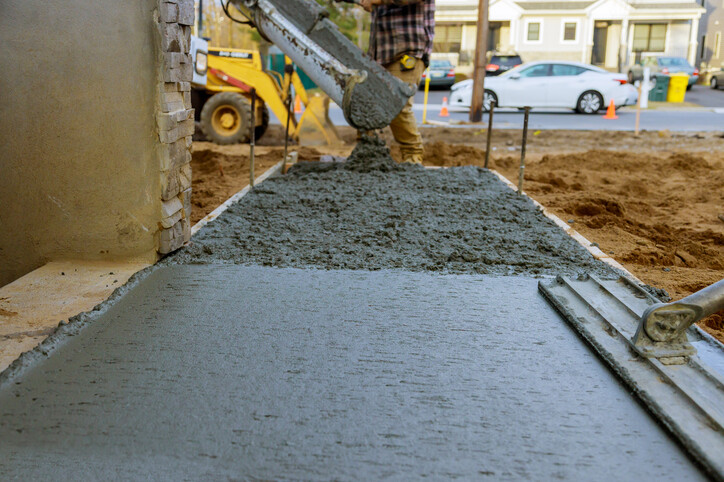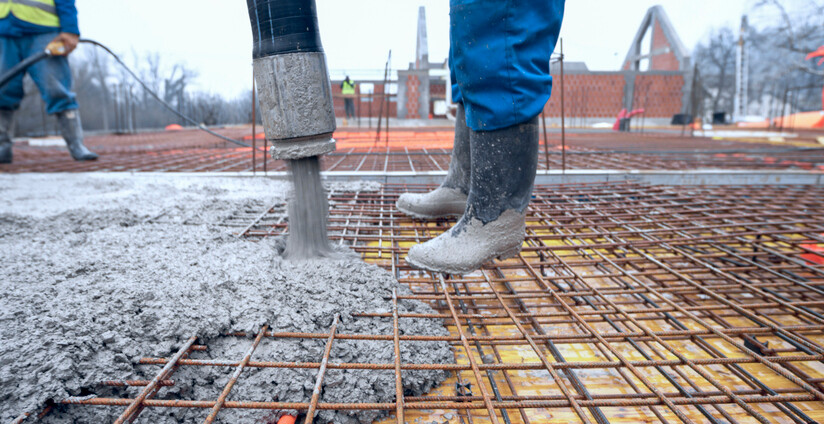 A concrete slab is one of the most basic elements of many construction projects. That said, getting it right is part art and part science. Pouring concrete slabs is a process that requires planning and attention to detail, as well as a basic understanding of the properties of concrete. Each stage of the process, from surveying and site preparation to pouring and finishing, plays a crucial role in ensuring that concrete slabs are both functional and durable.
A concrete slab is one of the most basic elements of many construction projects. That said, getting it right is part art and part science. Pouring concrete slabs is a process that requires planning and attention to detail, as well as a basic understanding of the properties of concrete. Each stage of the process, from surveying and site preparation to pouring and finishing, plays a crucial role in ensuring that concrete slabs are both functional and durable.
In this guide we will cover basic concepts regarding concrete and offer an overview of the process, as well as the equipment required in each step. At Drogheda Hire and Sales, we offer a comprehensive selection of tools and equipment specifically tailored for concreting projects and other DIY endeavours, don’t hesitate to get in touch for more information.
Surveying, Site Grading and Soil Compaction
1) Surveying:
In order to pour a concrete slab it is necessary to assess the terrain to determine the exact position of the slab as well as the right gradient, or angle of ascent or descent of a surface.
Incorporating the appropriate gradient into the terrain ensures effective drainage away from structures. In the context of concrete slabs, a gentle gradient is often needed to prevent water accumulation. Employing instruments such as one of the various models of Topcon laser levels allows for precise measurements for positioning stakes and marking the slab's perimeter with string.
2) Ground preparation:
Machinery such as Vermeer and JCB skid steers or the Hitachi ZX38U 3.8 tonne excavator are a great choice for earth preparation. By employing the front blade of the excavator, soil can be manoeuvred and graded accurately to facilitate proper drainage and establish a level foundation. Furthermore, excavation may be required for various purposes such as laying foundations or creating drainage channels. Attachments such as a riddle bucket or screening bucket aid in soil preparation, while a ripper tooth assists in breaking up roots or eliminating tree stumps.
3) Compaction:
Compacting the earth is essential to secure the stability of the ground before pouring the slab. This task can be accomplished through various methods by using plate compactors, vibrating rollers or excavator attachments such as the Wacker compactor plate.
Adding a Coarse Aggregate Sub Base
The layer beneath the concrete slab, known as the sub base, serves as its support and foundation. Typically composed of compacted gravel or crushed stone, referred to as coarse aggregate, the sub base is crucial for ensuring structural integrity. This layer not only provides strength but also aids in minimising shrinkage. By layering and compacting gravel, both drainage and load distribution are improved. Opting for larger, angular rocks promotes stability through interlocking.
In regions prone to freeze/thaw cycles or heavy loads, thicker bases are advisable. To establish a robust coarse aggregate base, pour gravel in layers and compact each layer using a compactor plate, vibrating roller or compactor plate attachment. Adding water to dry gravel aids in compaction.
 Formwork and rebar reinforcement
Formwork and rebar reinforcement
Formwork, also known as shuttering or construction forms, serves as a temporary mould for shaping poured concrete. These forms, crafted from materials like wood, metal or plastic, dictate the slab's shape and dimensions.
Robust forms are essential for containing and supporting the concrete during pouring and curing. Wooden planks and stakes are assembled to create sturdy moulds tailored to the structure's specifications. Proper reinforcement of the forms is critical, as the weight of the concrete exerts pressure on the sides of the mould during pouring.
Rebar, short for reinforcing bar, is steel reinforcement placed within the formwork before pouring concrete. This reinforcement enhances the concrete's strength and prevents structural damage from cracking, significantly boosting its durability.
Pouring Concrete, Vibrating and Screeding
Before looking into the methodology, it is important to first define what cement and concrete are. Cement is a binding agent usually derived from limestone that mixes with water to allow aggregates (sand and stones) to bind together. This mixture of aggregates, coarse and fine, bound together with cement, is what makes up concrete.
- Pouring: During the concrete pouring phase, it is important to act quickly, and consider weather conditions such as sunlight, temperature, humidity and precipitation. Concrete sets faster in hot, sunny conditions with low humidity, necessitating swift work. Shaded areas, protected by surrounding structures or trees, will dry more slowly. Concrete can be delivered in mixer trucks or tools like Baromix or Belle concrete mixers can be used for on-site blending. Regardless of the choice, it is important to have a plan for the pouring stage beforehand.
Two critical processes during pouring are vibrating and screeding.
- Vibrating: Concrete vibrating involves using tools such as a vibrating poker to eliminate air bubbles from the freshly poured mix, compacting it and reducing voids for enhanced strength.
- Screeding: This process entails levelling freshly poured concrete using a screed board or straight edge to create a smooth, even surface. Power screeds, powered by petrol motors, offer a lightweight option that can be operated by a single person, reducing both costs and time.
Concrete Finishing and Control Joints
Once the screeding process has been completed and the concrete has dried sufficiently, the focus shifts to concrete finishing. Concrete floats are employed to redistribute the cement paste that rises to the surface, ensuring a smooth finish while minimising aggregate exposure. Both hand floats and power trowels are viable options, chosen based on the specific project requirements.
In preparation for concrete shrinkage and potential cracking, control joints and expansion joints are strategically integrated into slabs exceeding six square metres in size. Whether formed prior to the concrete curing or cut into the solid slab afterwards, these joints serve to direct the formation of cracks, thus mitigating structural concerns. Precision tools such as Cimar or Lissmas floor saws are utilised to create these joints.
Moist Curing
Curing marks the concluding phase of the slab creation process. Moist curing, which entails regularly wetting the fresh concrete surface, allows for gradual moisture evaporation This reduces the risk of cracks and shrinkage. This method, implemented during the initial seven days post-pouring, contributes to the development of a robust and enduring concrete floor.
The process of laying concrete floors demands attention to detail throughout. With proper planning and the use of quality tools and equipment, you can achieve enduring and functional concrete floors for all sorts of building projects.
Choose Drogheda Hire and Sales for Concrete Equipment Hire
At Drogheda Hire and Sales, we stock a wide range of concrete tools and equipment, as well as other machinery available for hire. If you would like to speak to us about hiring or buying any of our equipment for your project, don't hesitate to get in touch; we'll be more than happy to assist you.
Call us on 0419841419 for our Drogheda depot or on 01 9108757 for our Dublin depot, use our contact form or try our Enquiry Bot at the bottom left hand corner of our home page.
